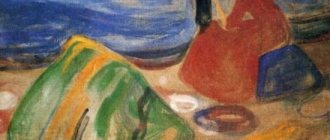28.The simplest type of learning is:
a) addiction;
b) classical conditioning;
c) operational conditioning;
d) complex learning.
The ideas of joint developmental activities of adults and children, cemented by mutual understanding, penetration into each other’s spiritual world, and joint analysis of the progress and results of this activity are
a) technology of multi-level training;
b) developmental training;
c) pedagogy of cooperation;
d) person-oriented technology
30. The method of activating thought processes by jointly searching for a solution to a difficult problem in an atmosphere of relaxation, ease, excluding criticism and self-criticism is...
a) inversion;
b) discussion;
c) method of heuristic questions;
d) brainstorming.
Your psychologist
With neuroses, this is a broader concept than internal conflict, since it is formed from more numerous sources and is not always psychologically motivated. At the initial level, it can be represented by constitutionally and antenatally altered neuropsychic reactivity in neuropathy, perinatal and postnatal organic cerebral pathology, and a genetically difficult combination of contrasting parental temperament.The tension that appears as a result of improper upbringing and conflicts, in contrast to previous sources, tends to increase with the age of children. What is pathogenic is, first of all, blocking of activity, lack of emotional response, excessive stimulation of capabilities and upbringing in general, which does not correspond to the characteristics of temperament, character and personality formation. Pathogenic situations of upbringing and relationships in the family are not necessarily recognized as traumatic, but nevertheless contribute to the development of mental stress. In addition, it can also arise as a result of psychological infection or induction - involuntary assimilation of the nervous state of adults and peers with whom the child has been in direct and close communication - contact for a long time. This is typical for emotionally sensitive, spontaneous and impressionable children, who seem to transfer onto themselves and absorb the emotional state of loved ones and significant others, empathizing, sympathizing or imitating, identifying with them. The psychological mechanisms of high emotional imprintability, selective suggestibility, affection and love are also at work here.
A chronic psychotraumatic situation as a source of tension should be discussed in the presence of experiences that are insoluble for children and constitute the content of an internal conflict. Against this background, additional mental traumas - emotional shocks - increase the pathogenicity of the life situation, since the child cannot cope with them, survive them. Together with internal conflict, communication problems and an unfavorable combination of life circumstances, this allows us to talk about the emergence of an unsuccessful, traumatic life experience or a state of chronic distress as the main source of pathogenic tension in neuroses. The situation is complicated by the fact that children with neuroses cannot, due to their limited and already psychogenically deformed life experience, upbringing conditions and family relationships, emotionally respond to the accumulating neuropsychic stress. They are forced to suppress it, which exceeds the limit of adaptive capabilities and further changes the neuropsychic reactivity of the body. In this case, there is an unproductive expenditure of psychophysiological resources and capabilities, their further overstrain and painful weakening in general. The consequence of chronic mental stress will be an increase in cerebral asthenic disorders, fixing experiences and complicating the further restoration of neuropsychic forces. At the same time, mental tolerance to the ongoing effects of stress factors decreases, anxiety and emotional instability increase, vegetative-vascular and somatic disorders appear or intensify, and the overall endurance and resistance of the body decreases. Together, this allows us to talk about the emergence of a detailed clinical picture of neurosis.
The development of long-term mental stress into neurotic, pathogenic-causal stress can be judged by the following psychogenic changes, taken in the dynamics of their development: 1) overstrain of psychophysiological capabilities and body systems; 2) affective processing of life experience (in the form of recording experiences, emotional instability and anxiety); 3) increased sensitivity to the effects of further threats to the “I” (the effect of emotional idiosyncrasy or sensitization); 4) reactive, psychogenically determined change in attitude towards oneself and others (the formation of self-doubt, affective-anxious and egocentrically defensive type of perception); 5) the emergence of defensive-avoidant behavior motivation (when the child “does not hear” and does not respond to traumatic stimuli from the external environment - the phenomenon of “selective inattention”, when he avoids difficulties and dangers that can further reduce the sense of “I”, when afraid and feels insecure in new, unusual communication situations); 6) decrease in vital activity, energy, biotone in general, changes in reactivity and the development of central pathophysiological changes of a functional nature; 7) a clinically defined violation of regulatory and adaptive (adaptation) neuropsychic mechanisms, including the vegetosomatic activity of the body in the places of its least resistance.
We have already touched upon the question of why mental stress during neuroses does not decrease, but increases, reaching a critical level. This is partly due to the specific manifestation of protective psychological mechanisms. In the traditional understanding, S. Freud (1926) and A. Freud (1936) regard them as involuntary forms of mental response, having as their motive (goal) the elimination of anxiety as awareness of a conflict situation that is unpleasant for the individual. The starting points for the development of this view were the following: 1) the perception of threat is accompanied by the mobilization of defense in order to support the self; 2) experiences that are incompatible with a person’s self-image tend to be excluded from awareness; 3) unconscious transfer of one’s own feelings, desires, and inclinations to another person, if a person does not want to admit to them, understanding their social unacceptability; 4) rationalization of feelings and drives as a means of their social control.
In the present, the main defense mechanisms are: repression, projection, denial (refusal), rationalization, sublimation, isolation and regression. Subsequently, a number of researchers contributed to the development of the doctrine of defense mechanisms. In this regard, mention should be made of hypercompensatory psychological mechanisms (Adler A., 1928); protective-passive and protective-aggressive behavior (Sukhareva G. E., 1959); three stages of development of the adaptation syndrome: anxiety, protection and exhaustion (Selye H., 1974); the protective significance of neurotic symptoms themselves and reactive character shifts (Ivanov N.V., 1974); transformation of negative attitudes and their replacement in the system of motives in the form of substitutions (Bassin F. E., Rozhnov V. E., Rozhnova M. A., 1974). In patients with neurasthenia, the leading types of psychological defense are denial and rationalization; in obsessive-compulsive neurosis - isolation of affect; with hysteria - repression (Tashlykov V. A., 1981).
Children with neuroses are not characterized by such a type of defense as projection, but it is often found in psychopathic development. In children with neuroses, responsibility for current events is attributed to themselves with the appearance of feelings of guilt and rudimentary ideas of self-deprecation. Characterized by silence, confusion, and frustration, when the child is lost and cannot say anything, giving the impression of being “guilty without guilt.” Normally, there is an average type of reaction, when children do not allow themselves to be offended, revealing a flexible, situational type of reaction. Sublimation occurs in adolescents with dysmorphophobia and psychogenic anorexia as part of obsessive neurosis, when the emerging sexual desire and secondary sexual characteristics are rejected as something dirty and shameful in contrast to high academic achievements. Children with obsessive neurosis are also characterized by excessive rationalization of feelings and desires, hypertrophy of mental activity, moral prohibitions to the detriment of emotional perception and spontaneity in expressing feelings. In hysterical neurosis, the leading types of psychological defense will be repression (often in the form of amnesia of unpleasant experiences) and regression - a psychogenic, reactively caused transformation of the “I” like a return to earlier, emotionally acceptable stages of mental development. Regression and rationalization are also observed with neurasthenia, while fear neurosis is more characterized by isolation and fixation of affect, its germination by anxiety and fear.
When a neurosis occurs, an increase in the activity of inhibitory processes has a certain protective value, creating pathophysiological zones of extreme inhibition and protecting nerve cells from further overstrain and exhaustion. Such a child becomes more and more slow, “fussy” when studying, eating, dressing, preparing homework. This prevents further accumulation of neuropsychic tension, the child gets less tired, receiving a temporary respite. Selective inattention also serves the same purpose, when children with neurosis stubbornly “do not hear” the demands of adults, endless prodding and coercion, are often distracted while preparing lessons, and begin to engage in other, more pleasant and emotionally rich activities. It is also difficult for children with neuroses to begin any mandatory, responsible and strictly regulated activity, since it requires a high concentration of attention and performance, already weakened as a result of neurosis. At the same time, parents, not understanding and often ignoring the painful nature of existing disorders, sharply increase psychological pressure on children, overly control lessons, force them to rewrite everything again at the slightest mistake, and constantly read morals to their children that they cannot learn. Typical in this case is the repression of experiences in dreams, their affective processing, which we have repeatedly discussed. However, sleep itself loses many of its natural functions, turning, due to night terrors, into a source of danger rather than a source of safety and restoration of strength.
| Next > |
a) assimilation of knowledge in a ready-made form, without revealing ways to prove its truth;
b) studying educational material element by element in a logical sequence;
c) focus on independent cognitive activity of students to search for new concepts and methods of action;
2 pages, 692 words
Main activities. 1. Game activity does not create socially significant results, but it means a lot for the formation of a person as a subject of action
1. Game activity does not create socially significant results, but it means a lot for the formation of a person as a subject of activity. In role-playing games, children, imitating adults, master forms of social behavior and communication between people - they become socialized. In games according to the rules (board games, sports), physical and mental characteristics are developed and trained. The game takes on special significance...
d) equipping students in a short time with knowledge of the basics of science in a concentrated form.
Causes of nervous tension
Mental stress occurs against the background of any condition that weakens the human nervous system
. These include:
- Somatic diseases and their complications, especially chronic pathologies accompanied by general intoxication (renal failure, infections) have a particularly strong impact;
- Physical fatigue;
- Poor lifestyle, including lack of rest;
- Fast pace of life in big cities;
- Constant stress (at home and at work).
Chronic intoxication (drugs, alcohol) has a damaging effect on the nervous system and leads to its rapid depletion.
Relieve stress through meditation
Mantra Japa, Antar Mauna and Yoga Nidra are very effective and easy to practice ways to achieve a state of meditation.
- Mantra japa or repetition of mantra penetrates the mind where thoughts are found as seeds. From there they act on deep-seated feelings and expel them. However, in the initial stages of mantra practice, the mind becomes more restless. But when thoughts lose their power, the burdened mind becomes calmer. Tensions are released, leaving the world behind. The easiest way to practice mantra japa is with beaded strings or beads.
- Antar Mauna or Inner Silence is a practice in which one simply observes the behavior of the mind without any judgment or hindrance. The practitioner simply observes what is happening in his mind without any bias or analysis. When the mind ruminates on a thought, we can become sad or happy. The idea of this practice is not to touch our thoughts, but to simply look at them with detachment, like in a movie. Observe your thoughts as if they were not yours. This practice will also help in releasing tension.
- Yoga Nidra or psychic sleep is a relaxation technique where you are not actually sleeping. When lying down, every part of the body relaxes, and then the mind relaxes. This is a powerful technique that results in powerful release of tension and strengthening of goals. This practice takes only half an hour a day.
Like anything new, it will take you some time to master meditation practices. It may take several attempts to achieve a meditative state, depending on the state of mind and how relaxed or agitated the person is. There is no need to be discouraged, just keep practicing to get relief.











